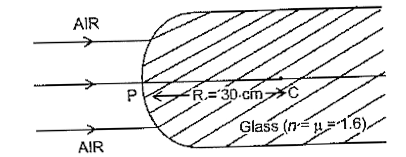(a) Figure below shows a parallel beam of monochromatic light incident on a convex sperical surface, radius of curvature R=30 cm, which separates glass (refractive). Find the distance of image formed.
(b) A ray of light which is incident in air on the surface of a glass block is deviated through 15∘. The angle of incidence in air is 60∘. what is the angle of refraction in glass ? Also, claculate the critical angle for a glass-air interface.
(a) From the relation nv−1u=n−1R calculate v.
(b) Calculate it from aμg=sin(δm+A2)sin(A/2)and.aμg=1sinic
Similar Questions
Figure below shows a parallel beam of monochromatic light incident on a convex spherical surface, radius of curvature R = 30 cm, which separates glass (refractive index - 1 6) from air. Find the position of the image formed due to refraction of light at this single spherical surface.
 View Solution
View SolutionA ray of light is incident on the surface of a glass plate of refractive index √3 at the polarising angle . The angle of incidence and angle of refraction of the ray is
View SolutionFind the lateral shift of a light ray while it passws through a parallel glass slab of thickness 10 cm places in air. The angle of incidence in air is 60∘ and the angle of refraction in glass is 45∘.
View SolutionA ray of light travelling in air strikes the surface of glass at angle of 450. The angle of refraction in the glass will be :
View SolutionA ray of light is incident on the surface of a glass plate at an angle of incidence equal to Brewster's angle ϕ. If μ represents the refractive index of glass with respect to air, then the angle between reflected and refracted rays is
View SolutionA ray of light is incident on a surface of glass slab at an angle 45∘. If the lateral shift produced per unit thickness is 1/√3, the angle of refraction produced is
View SolutionA ray of light is incident on a rectangular plate at an angle of incidence 60∘. The light ray suffers a deviation which is 25% of the angle of incidence. The refractive index of the glass will be
View SolutionA ray of light in air is incident on a glass plate at polarising angle of incidence. It suffers a deviations of 22∘ on entering glass. The angle of polarisation is
View SolutionLight falls from glass (μ=1.5) to air. Find the angle of incidence for which the angle of deviation is 90∘.
View SolutionThe angle of incidence is always smaller than angle of refraction when a ray travels from air to glass. ______
View Solution

